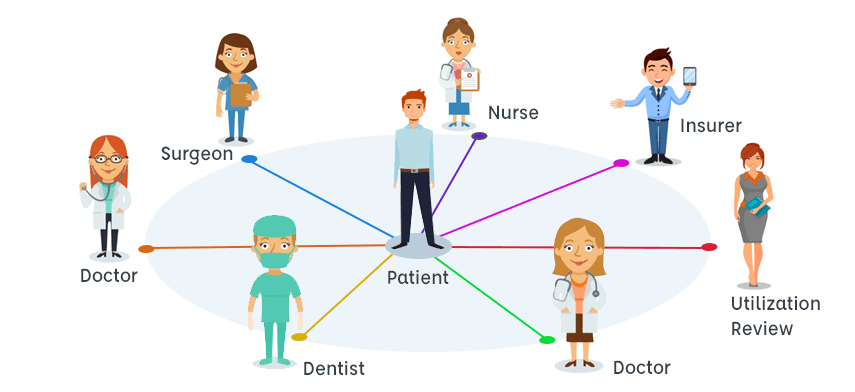Patient centricity is a term that has been elusive in context with the pharma industry. In terms of research and development, many pharma companies are working hard to incorporate strategies to achieve patient centricity.

The term ‘patient centricity’ has a different meaning than it had about ten years back. These days, patients are well aware of their health conditions and they prefer to receive clear and transparent healthcare services. With the mass-level availability of smartphones and the internet, patients can find health-related information at the tap of a button.
Healthcare service providers, pharma companies, and medical practitioners are looking towards patient centricity as a solution to bridge the gap between patient’s demands and the available healthcare options. However, the masses need to be educated and informed about the concept of patient centricity, its importance, and future implications.
Que 1: What Is Patient Centricity?
Patient centricity is defined as the process of developing healthcare services around the patient. It involves seamless collaboration between medical practitioners, patients, and their families to achieve decision making as per the patient’s demands and requirements.
It also includes eradicating the difficulties in communication with the patients – delivering specific education to the patients and their families to understand a particular medical condition, and to make them participate in their own care.
Que 2: Why Is Patient-Centric Approach Important?

The patient-centric approach is essential because it lays the foundation of high-quality healthcare. It not only increases the engagement among the patient, doctors, and family members but also helps educate the patient about the health condition and the possible treatment options. By involving the patient and the family members in the decision-making process, healthcare providers can ensure better health outcomes.
Que 3: What Are the Challenges Faced When a Patient-centric Approach Is Put in Effect?
There are a number of challenges related to the delivery of a patient-centric approach.
- It is a highly time-consuming process to indulge the patient and its family members into the decision-making process to discuss a possible treatment.
- Patient centricity is also subject to a number of barriers due to a patient’s unwillingness towards a particular treatment or medicine.
- The physicians and the support staff must be properly trained to deliver patient-centric healthcare.
- The transition to a patient-centric approach can be a new experience for the entire healthcare team, as well as for the patient and its family members.
- It is a hectic task to ensure that the discussion and decision-making, remain collaborative and not enforced.
- Due to its high costs, the patient-centric approach can cause financial challenges for the healthcare organization.
- The patient-centric approach may include the consumption of resources that are not completely reimbursed by the health insurance providers, and hence, it can be a hassle for the patient as well.
Que 4: What Are the Main Habits of Patient-Centric Providers?
Patient-centric healthcare providers utilize many data-dependent tools and techniques to deliver optimized healthcare services. The patient-centric approach involves the use of the right tools and equipment such as a multi-provider patient portal, electronic health records (EHRs), and a range of biometric devices to proliferate shared decision making and multi-staged care. Besides, to maintain trust, healthcare providers allow the patient to control their records in a hassle-free manner through dedicated patient portals.
Que 5: How Is Patient-Centric Care Different from Patient-Centered Care?
Patient-centered care is the delivery of healthcare services by forming a partnership of medical practitioners, patients, and their family members to achieve optimized decision-making, as per the preferences of the patient.
The patient-centric approach involves the interactions originating from the patient. By using wireless technologies – personalized data and interactions initiated by the patient are managed by both the patient and the healthcare provider. Further, the information related to personalized medicine is obtained from Big Data mining and genomic data processing techniques.
As compared to the patient-centered approach, the patient-centric methodology provides more efficient diagnose of the exact medical condition of a patient, and its subsequent treatment options.
Que 6: Why Is Patient-Centric Approach Best?
The patient-centric approach is considered as the best approach to deliver healthcare because it promotes and enhances understanding among patients about their health condition, treatment options, and risk factors. With this information, patients and their caretakers can choose the best program for their wellbeing.
Further, by collaborating with the patient and its family, the medical practitioners can deliver personalized healthcare services to the patient. As compared to other healthcare delivery approaches, patient-centric approach puts the control in the hands of the patient. Through this approach, a patient can monitor and view his records including – treatment, health condition, medicines, and risk factors.
Que 7: Is Patient-Centered Care the Same as Person-Focused Care?
Both patient-centered care and person-focused care are based on the identification and diagnose of health problems experienced by different individuals. Although, both patient-centered and person-focused care is related, there are contrasts between the two terms as well. While patient-centered care relies on the communication and interaction between a patient and the physician in the clinic, the person-focused care is the prevention and management of an individual’s health problems over time.
A patient-centered approach is traditionally a visit-oriented approach. In contrast, the person-focused approach involves an emphasis on the individual and not just the disease. Technically, a person-focused approach developed over time with coordination and collaboration with the patients. The main essence of the person-focused approach is to generate important insights about a patient over time.
It extends beyond the communication between the doctor and the patient in a clinic and involves important knowledge of the patient gathered over considerable time. It also includes collaborative decision making achieved through a long-standing relationship.
Que 8: How Is People Power Building Patient-Centric Pharma?
Even with the establishment of the fact that patient-centric pharma is highly important, only a minority of the companies know how to achieve it. As per the Aurora Project’s Second Annual Patient-Centric Benchmark Survey on the employees of leading pharma companies – 76% of the workers believed that their company was making a difference by adopting the patient-centric approach. Around 81% of the workers felt proud in telling people outside their industry about their company’s achievements.
By connecting the thoughts of the pharma company workers with the patients, builds the trust factor and creates new pathways for patient-centric healthcare. As per the survey, the workers also felt inspired and empowered to talk about patient-centric ideas.
Que 9: What’s the Value of Patient Centricity?

Through patient centricity, traditional health care has evolved into a personalized healthcare service involving relevant patient insights, data-driven tools, and a partnership between healthcare providers and patients.
Through patient centricity – a literal and figurative collaboration between healthcare providers, pharma companies, and patients can be achieved. With detailed patient insights at their helm, pharma companies and healthcare providers can work on a common target – to improve the healthcare services delivered to the patient.
Que 10: How Is People Power Building Patient-Centric Pharma?
Through patient-centricity, physicians and the medical support staff can build strong relationships with their patients. Through every setback and failure, medical practitioners search for new and innovative ideas to solve complex medical problems.
The very nature of medical science drives the researchers to innovate and develop new ideas. Through patient-centricity, researchers can focus on people with different biological characteristics. Highly complex medical conditions like cancer require targeted medicines and patient-centric approach is beneficial in such cases. Furthermore, through this approach, physicians are inspired to provide cutting-edge healthcare services to each of their patients.
With the expansion of healthcare innovations across communities and cultures, clinical trials and programs have led to the discovery of innovative treatment options including new biosensing techniques, rapid assessment technology, and ResearchKit framework that have been instrumental in making a considerable difference.
Que 11: What Is the Future of Patient Centricity?
Healthcare experts believe that we are on the brink of a patient-centric care revolution. The future holds a bright prospect for the delivery of personalized healthcare services. Choosing a patient-centric healthcare approach creates a formalized mechanisms for the inclusion of patients’ perspectives. This will aid in critical decision-making regarding research and market access.
Further, individual data collected from different patients will help in the development of improved personalized care facilities. In addition, pharma companies striving to enhance their patient-centric approach to streamline their interaction with the patients.
Conclusion
Patient centricity reflects a revolutionary approach to healthcare delivery. Traditionally, it has been viewed as an approach that puts the patient at the center and the entire range of healthcare services around it.
However, over the past few years, the vision for patient centricity has certainly changed. It incorporates – empowerment, awareness, and participation of the individual patient. These days, patients have all access to their medical records and data. Healthcare has become a collaborative affair between the medical practitioners and the patients.
For physicians, their role has changed from being the sole expert to an interpreter of different medical conditions. The physician has also become the coordinator between the patient and the entire healthcare delivery system.
As this new relationship has created a fundamental shift in the delivery of healthcare services, researchers, and health IT experts are embracing it in the healthcare industry. However, it still needs time to be accepted at a large-scale level. There are still some challenges that pose a hurdle in its mass-level implementation, but the future for patient centricity is highly promising.
Author's Bio

Shailendra Sinhasane (Shail) is the co-founder and CEO of Mobisoft Infotech. He has been focused on cloud solutions, mobile strategy, cross-platform development, IoT innovations and advising healthcare startups in building scalable products.



